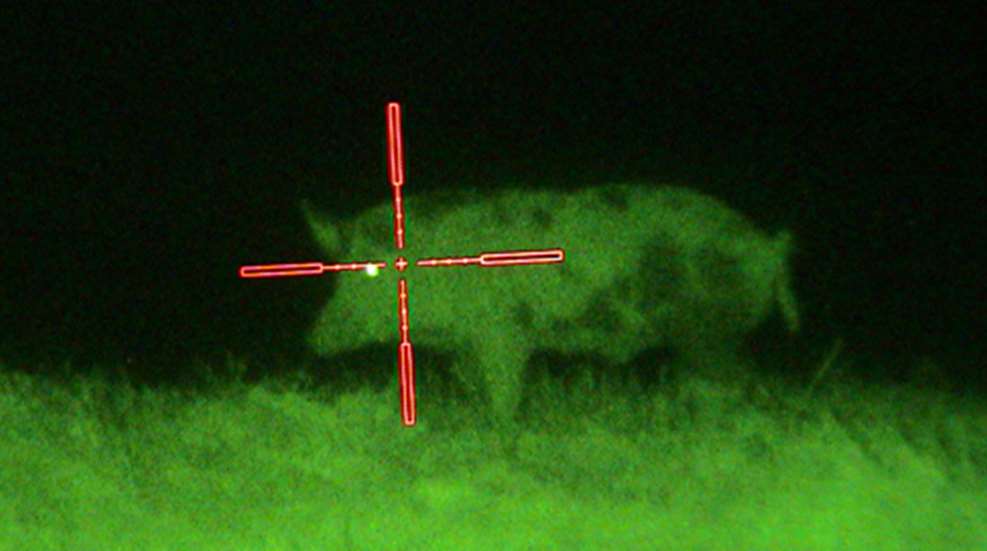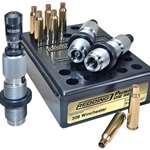
Feral pigs, which originally arrived on our shores on the ships of early explorers as domestic livestock, have become a major nuisance in this country.
With no natural predators at maturity and the ability to reproduce at as early as 7 months of age—birthing an average of four to six piglets (and as many as 10 or 12 under favorable conditions) as often as twice a year—the wild pig is spreading throughout the country and leaving a wake of destruction wherever it goes. Wild hog crop damage is estimated to be as high as $1.5 billion nationwide, and compounding their devastation is the fact that they compete with native species like deer for forage foods such as acorns. Hog depredation of ground nesting birds has been linked to a nearly 25-percent decline in turkey and quail nest success and populations in some areas.
Hog aren’t just fertile and destructive, however, they’re also cunning. One of the most intelligent animals on the planet—they rank right behind primates and dolphins when it comes to intelligence—pigs also have a sense of smell that rivals a whitetail, will go nocturnal with any hunting pressure and live and work together in a hierarchy that resembles a military unit.
To combat their ingenuity and sheer numbers, Rod Pinkston, owner of Jager Pro Hog Control Systems in Columbus, Ga., combines his military training and childhood days spent studying swine behavior on the family hog farm in order to wage war on the invading non-native vermin. Combined with his partners, Lance Hopper and Chris Monhof, the trio has nearly 70 years of tactical and shooting experience gleaned from military service around the globe and competitive shooting at the Olympic level. Each year, they kill more than 1,000 hogs in 100 days of hunting in Georgia.
Pinkston and his crew use two primary means of eradicating sounder groups—multi-generational packs of hogs usually led by a senior matriarch—from an area. First, there is trapping with Jager Pro-designed pens, gates and trigger mechanisms from December through March. Then the trio leads hunters into battle using night-vision scopes mounted on AR-10s to eradicate those that remain.
“Our goal is to have 100-percent efficiency on all the hogs coming to the trap,” said Pinkston, noting that proper conditioning of animals to the bait—a highly sought-after food source during the lean winter months— over several days and in conjunction with large traps and doors enable them to catch entire sounder groups in one fell swoop. “If we can eliminate 70 to 80 percent of a local population with traps, then we get a big jump on controlling them and can clean up with hunters.”
The large traps used by Jager Pro catch more hogs at one time than typical one-hog traps put out by the USDA and other agencies to fight hog depredation. In Jager Pro’s YouTube videos, you can witness the effectiveness of the traps and watch how intelligent and cautious wild hogs are when it comes to trapping.
When it comes to eliminating those hogs not captured in traps, the fun for hunters begins. In order to eliminate more hogs, Pinkston focuses on guiding hunters at night in order to capitalize on their dominant activity period—because 80 percent of hog movement and feeding takes place at night.
Setting up on food sources through spring, summer and very early fall, Pinkston’s clients spot and stalk large single boars and sounder groups—often times numbering as high as 20 animals— ravaging agriculture fields.
Rapid fire from AR-10s chambered in .308 ensues after hunters are able to stalk into the wind to distances under 100 yards. With each piglet, sow and boar killed, a farmer’s crop damage is lessened and native wildlife species face less competition for vital food sources.
To that end, Winchester has come out with the first cartridge produced specifically for wild hog hunting. The Winchester Razorback XT will initially come in the hog-popular calibers of .308 Win and .223 Rem, which should hit shelves in early 2012. Other caliber offerings will follow.
The Razorback XT is comprised of a lead-free hollowpoint bullet for delayed expansion on the largest heavy-hided, thick-boned and ornery sows and boars. The beveled sides of the bullet compress the hollowpoint cavity and strengthen the expanded segments.
After putting several rounds into and through two hogs—a 140-pound and 276-pound boar— while hunting with Pinkston and his crew, not a petal was broken and all recovered bullets expanded fully and penetrated through as much as 16 inches of dense hog body cavity and bone. Those that weren’t recovered were either misses or passed clean through even the larger hogs.
While the Razorback XT can be fired from conventional hunting rifles, they’re specifically designed for use in AR-10 and AR-15 firearms and even feature low-flash powders for more efficient use in low-light situations, or as in Pinkston’s case, with night vision equipment.
The .308 Win comes in a spry 150-grain load and will retail for approximately $35 for a 20-round box, while the .223 Rem is propelled by 64 grains and will sell for about $25 for a 20-round box.
Hunters wishing to try their hand at using night vision to hunt down the irrepressible feral hog have two hurdles to overcome—in addition to the intelligence and hardiness of the animal itself.
First, night-hunting laws, seasons and available targets vary greatly from state to state. The use of high-tech equipment such as night vision is even more contentious and regulated even more so —it’s estimated that roughly 40 percent of states prohibit the use of the devices.
While some states allow night hunting for predators such as bobcats, or furbearing animals like raccoons, they prohibit the use of night vision when taking other animals. Yet, those same states might allow the use for non-native, non-game animals like the invasive feral pig. It’s all very much dependent upon individual state laws, and as such you’re best served by checking with the state and then double checking with local law enforcement.
The second difficulty is obtaining quality night-vision or thermal optics at an affordable price. If you find gear on the cheap, it’s probably not worth buying—it could not only lead to issues on the hunt, it could land you in hot water with the authorities. That’s because through night vision, deer and feral hogs look very similar in profile and body posture. With lesser gear you might find yourself putting a stalk on a game animal for which night hunting is illegal in all states.
You can count on spending several thousand dollars on night-vision or thermal scopes. Jager Pro sells quality night-vision and thermal optics, many of which they helped companies develop. Night-vision scopes start at $4,000 and thermal scopes go for $14,700. A pricey setup for sure, but it offers a unique hunt with higher success rates than daytime hog hunting.





































